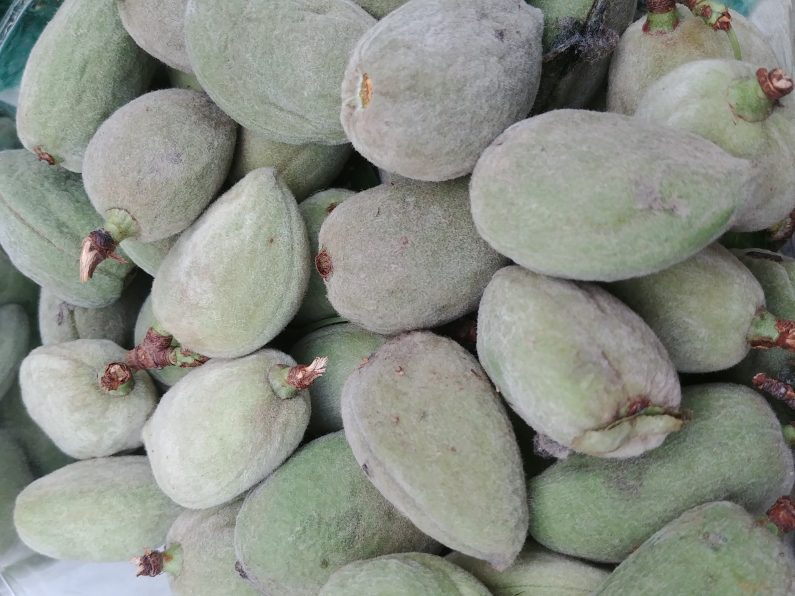“Tu B’Shvat has arrived! The Holiday for the Trees!”
So goes the famous Hebrew children’s song in celebration of the holiday known as Tu B’Shvat (translated as the 15th of the Hebrew month of Shvat). On this day, Jews around the world celebrate the fruits of trees, and typically eat dried fruits and nuts in honor of the day. But despite what it says in the song, Tu B’Shvat in its ancient origins was actually not a holiday at all.
The earliest source for marking the day comes from the Mishna, the core of Judaism’s legal code. The first mishna in tractate Rosh Hashana lists this day as one of four “New Years” on the Jewish calendar. (Rosh Hashana is the Hebrew word for New Year.) For each of them, it tells us what specific year begins on each of the four days.
What does it mean to have multiple new year days? Think of it as when a company picks a date on the calendar as the start of its “fiscal year.” That delineates what income and expenses fall in one tax year, and what in the next. But it is not required to fall on January first. In the same way, the first of Elul (another Hebrew month) would be the start of the fiscal year for animals. If an animal was born before that date, its Temple tithe would be calculated with the previous year, and if after, then with the animals born the following year. The same holds true for Tu B’Shvat, in relation to the tithing of fruits that grow on trees. Rather than New Year for the trees, it just marked the start of a new year for them.
To modern ears, the term New Year translates to a celebratory holiday. But we have no records of any kind of celebrations taking place on this day in antiquity. That being said, it very clearly was a day connected with Jewish Food, in the sense not that it related to foods that were specifically Jewish in their essence, but in its connection to how Jews relate to food.
So how do we get from a “tax day” of sorts to a celebration (sometimes with a semi-formalized Seder, akin to that of Passover) and nowadays to a full-on environmental awareness day? And how should we be observing this day in contemporary times?
Becoming a Holiday
For the bulk of the past 2000 years there have been only small clusters of Jews living in Israel (though there was never a time, since the Jews controlled our own destiny here, that the land was entirely empty of Jews). The 16th century, however, brought an influx of Jews via the Ottoman Empire that included Israel in its boundaries. The Ottomans welcomed many of the Jews who had been expelled from Spain in 1492, and a good portion settled in this part of the Empire, especially in the northern city of Tzefat (Safed). It was there, during that century, that modern kabbalah (Jewish mysticism) began to flourish and gain in popularity.
Among other things, kabbalists found deep meaning and significance in the spiritual aspects of seemingly mundane and every day things. One of the major ideas they developed was an attempt to elevate these physical things to a more spiritual level. And apparently, among other things, they reconnected with the ancient tax day of Tu B’Shvat, turning it into a more spiritual “holiday.”
18th century records are the first to mention the Tu B’Shvat Seder, claiming its roots went back to R. Isaac Luria (aka “the Ari,” the main figure in 16th-century Tzefat kabbalism). In fact we do not find a formal Seder connected with Luria via early records, though we do find mention of him marking the day by eating many fruits, and singing their praises. Regardless of whether the custom was begun during Luria’s time, or over the succeeding two centuries, there is no doubt that it was from within the community of the Tzefat kabbalists that the modern celebration began. Various customs developed, such as eating fifteen different fruits, or thirty, or as many as one could possibly get ones hands on!

Whether one finds meaning and significance in the spiritual messages of kabbalistic interpretations and accepts them as “true,” there is a fairly obvious source one can point to for why this day held such importance for the community. As the first major wave of Jews to return to the land of Israel in hundreds of years, and living in an Ottoman Empire that valued the Jews and generally looked favorably on them, any Jew living here in those centuries would have felt a profound sense of gratitude to God and a desire to reconnect with the land. And what better way to do so than through its produce?
Israel climatically is part of a region that only gets rain in the winter season. Trees are often bare or at least more barren in the summer time, as it has been months since they received direct rainwater. Only in the winter do we have the pleasure of seeing trees full of lush greenery and going into bloom. This is the logical reason why in antiquity it was this time of year that was set as the start of the fiscal year for trees. Once the new flowers form, we are obviously entering the new phase of the coming year’s fruits.
In fact, the Tu B’Shvat song I began this piece with begins with a famous line about the almond tree in bloom. Almonds grow all around Israel and are the first tree every winter to go into flower. Their numerous white flowers are gorgeous, and have grown into a special symbol of the day in Israel. Once we see the almond flowers on the trees, we know that we are getting over the hump of the winter, and heading towards Spring. We even get fresh green almonds to eat a few weeks later, which is what the main picture above shows — the white pit in the middle of those fuzzy pods are actually the almonds you typically eat, but the pods themselves are edible raw or cooked with various other dishes.
Living in Israel, and seeing this annual renewal, automatically became a period of celebration for the Tzefat kabbalists. I can tell you personally how excited we get when various fruits here come back into season. (Unlike in America, where I came from, and where most fruits and vegetables are available year-round via imports and long-distance transportation, most of the produce we consume in Israel is grown locally and is thus only eaten seasonally.) It would thus be an obvious day for the kabbalists to choose to elevate from a mere feeling of human emotion to a level of holy thanks.
The Tu B’Shvat Seder custom spread fairly quickly, at first through the immediate region — the Arab world and the Ottoman Empire — and in time further to Jews in other areas. Jews outside the land appreciated the celebration of God’s gifts of fruit, and specifically his gifts in the Land of Israel. So in time, Jews who lived here would send shipments of dried fruits and nuts to Jewish communities in other far-flung regions, so they too could partake of the blessings of the land.
The Modern Stage
Tu B’Shvat would transform again in modern times (and in fact did so twice in the last hundred-plus years). By the late 1800s, large waves of Jewish immigrants arrived in Israel. Many of them, wanting to connect to the land like their forbears, began engaging in agriculture as they built new settlements. Tu B’Shvat here then gained a new custom: planting trees.
To this day, many people make a point of planting trees in Israel on Tu B’Shvat. Typically these days, the trees they plant are forest varieties — conifers or general, non-fruiting deciduous trees. But in 1884, the new town of Yesod HaMaalah gained over 1500 new saplings in a single day. And most, if not all, were fruit-bearing trees. They included etrogim (citrons), figs, pomegranates and mulberries. Clearly, this new tradition was more directly connected with the “fruits of the land” concept.
From then until now, planting trees has become an integral part of marking the day. Some see it as “Jewish Arbor Day,” a day with more generic environmentalist roots. Which of course led to the most recent transformation of the day.
Towards the end of the 20th century and up to our day, Tu B’Shvat has become more than merely a celebration of trees. It has grown from Jewish Arbor Day into “Jewish Earth Day,” full of all sorts of programs focusing on general environmental awareness and sustainability efforts. At this very moment, for example, there is a large online event being held through the 31st of the month: The Big Bold Jewish Climate Fest. The many sessions include ones on recycling, climate change activism and renewable energy. There are also sessions more directly connected to the day: various types of Tu B’Shvat Seders and programs about tree planting. (And readers of this blog may also appreciate the few food-related sessions, as well.) While this festival is obviously connected to Tu B’Shvat (without a healthy environment it is hard to have healthy trees and good fruit to eat), it has clearly come a long way from the origins of the day.
So Where Does That Leave Us?

One of the great ironies of Tu B’Shvat, as I see it, is the staying power of the dried fruit custom. For starters, at least here in Israel, there is no real reason for us to be eating dried fruits. (Apologies to my friends in Machane Yehuda who sell the stuff, and make a fairly good profit during this period every year.) We have plenty of delicious fruits that grow in Israel and that we can eat fresh. More importantly, the majority of dried fruits and nuts that we consume here aren’t even grown in Israel. We import them from places such as Turkey! So not only does consuming them work against the environmental aspects of the holiday, it is also contrary to this day’s celebration of the fruit of the Land of Israel.
I believe a perfect fruit for us to be eating in Israel for Tu B’Shvat would be oranges. They are in season right now, are delicious, and have historic connections to the modern era in this land. And if you insist on eating dried fruits here for “tradition’s sake,” at least make it something like dates that were grown here.
Beyond that, what should we make of the vast change of Tu B’Shvat’s character from ancient times until today? Frankly, I have no problem with it at all! It’s not like this was an actual holiday in ancient Jewish tradition that we now have altered in some fundamental way. Rather, it was a non-celebratory day on the calendar that we later invested with meaning, substance and reason to celebrate. There’s nothing wrong with that, in my book, especially when we recognize that the changes grew out of a love for the land of Israel and values that Jews have always held dear.
I say yes to celebrating Tu B’Shvat as a holiday, with or without a formal Seder. Yes to environmental awareness and tree planting. But no to dried fruit for the day, especially in Israel. But yes again to connecting the day to Israel itself. After all, that is what this day has always been about, from ancient times until today.
Now go eat an orange!







Howard Schulberg
Thank you & your brother for the informative articles.
Regards to your mom & dad